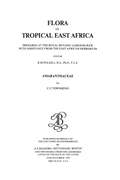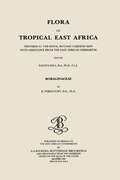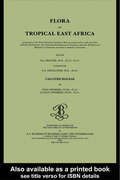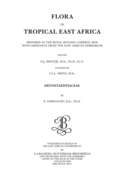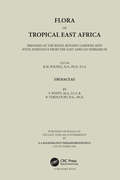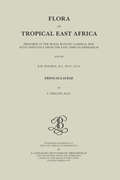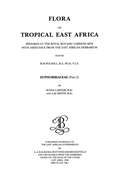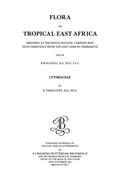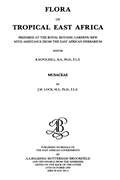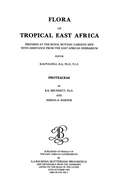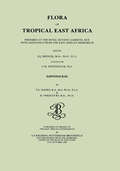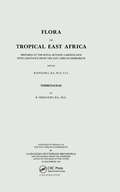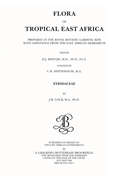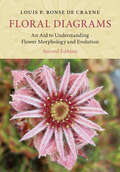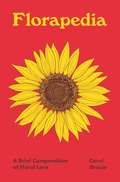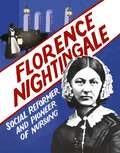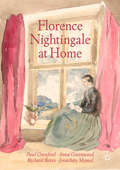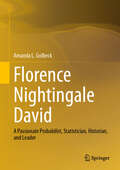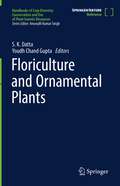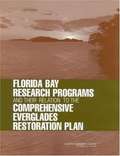- Table View
- List View
Flora of Tropical East Africa -Amaranthaceae (1985)
by C. C. TownsendThis volume focuses on the family Amaranthaceae. They are annual or perennial herbs or subshrubs, rarely lianes and large and mainly tropical family of some 65 genera and over 1000 species, including many cosmopolitan weeds and a large number of xerophytic plants.
Flora of Tropical East Africa - Anthericaceae (1997)
by Linger Nordal Shakkie Kativu Axel D. PoulsenThe Flora is prepared at the Royal Botanic Gardens, Kew in close collaboration with East African Herbarium and in liaison with the University of Dar es Salaam, the University of Nairobi and the Makerere University. Significant contributions are also made by specialists elsewhere. This reference should be of use to anyone concerned with the identification and utilization of plants in eastern Africa.
Flora of tropical East Africa - Balanitaceae (2003)
by H. J. Beentje S. A. GhazanfarPrepared at the Royal Botanic Gardens, Kew, in close collaboration with the East African Herbarium and in liaison with the University of Dar es Salaam, the University of Nairobi and the Makerere University, this series is designed to the highest academic standards and is a useful reference for anyone concerned with the identification and utilizatio
Flora of Tropical East Africa - Boraginaceae (1991)
by Bernard VerdcourtThe Flora of Tropical East Africa prepared at the Royal Botanic Gardens/Kew with the assistance from the East African Herbarium. A volume looking at the considerable family of around 2000 species (three-quarters herbs and subshrubs and the rest trees and shrubs).
Flora of tropical East Africa - Callitrichaceae (2003)
by H. J. Beentje S. A. GhazanfarPrepared at the Royal Botanic Gardens, Kew, in close collaboration with the East African Herbarium and in liaison with the University of Dar es Salaam, the University of Nairobi and the Makerere University, this series is designed to the highest academic standards and is a useful reference for anyone concerned with the identification and utilizatio
Flora of Tropical East Africa - Dennstaetiacea (2000)
by Bernard VerdcourtThe flora is prepared at Royal Botanic Gardens, Kew, in close collaboration with East African Herbarium and in liaison with the University of Dar es Salaam, the University of Nairobi and the Makerere University. Significant contributions are also made by specialists elsewhere. The flora is designed to a high academic standard and should be a useful resource reference for anyone concerned with the identification and utilization of plants in eastern Africa. Each family is published as a separate part.
Flora of Tropical East Africa - Ebenaceae (1996)
by B Verdcourt F WhitePart of a series of volumes on the flora of tropical East Africa, this text covers the Ebenaceae family.
Flora of Tropical East Africa - Eriocaulaceae (1997)
by Sylvia PhillipsThe Flora is prepared at the Royal Botanic Gardens, Kew in close collaboration with East African Herbarium and in liaison with the University of Dar es Salaam, the University of Nairobi and the Makerere University. Significant contributions are also made by specialists elsewhere. This reference should be of use to anyone concerned with the identification and utilization of plants in eastern Africa.
Flora of Tropical East Africa - Euphorbiac v2 (1988)
by Susan Carter A. R. SmithThis volume focuses on the family Euphorbiaceae. They are well defined tribe which includes ten other small genera of tropical and sub-tropical regions. Euphorbia are annual, biennial or perennial herbs, shrubs or trees, sometimes succulent and unarmed or spiny, with a milky usually caustic latex.
Flora of Tropical East Africa - Lythraceae (1994)
by B. VerdcourtThis book is a comprehensive review of the genera of Lythraceae, a flowering plant family of mostly trees and shrubs, found in tropical East Africa. It presents information on their character, occurrence, habitat, phenotypic variations and distribution of each of the species under these genera.
Flora of Tropical East Africa - Musaceae (1993)
by J.M. LockPart of a series on the flora of tropical East Africa, this work considers Musaceae. The flora is prepared at Royal Botanic Gardens, Kew in close collaboration with East African Herbarium and in liaison with the University of Dar es Salaam, the University of Nairobi and the Makerere University. Significant contributions are also made by specialists from elsewhere. The flora should be a useful reference for anyone concerned with the identification and utilization of plants in eastern Africa. Each family is published as a separate part. New parts are published annually. All back volumes are also available.
Flora of Tropical East Africa - Polypodiaceae (2001)
by Bernard VerdcourtPart of a series on the flora of tropical East Africa, this work considers Polypodiaceae. The flora is prepared at Royal Botanic Gardens, Kew in close collaboration with East African Herbarium and in liaison with the University of Dar es Salaam, the University of Nairobi and the Makerere University. Significant contributions are also made by specialists from elsewhere. The flora should be a useful reference for anyone concerned with the identification and utilization of plants in eastern Africa. Each family is published as a separate part. New parts are published annually.
Flora of Tropical East Africa - Proteaceae (1993)
by R. K. Brummitt Serena K. MarnerPart of a series on the flora of tropical East Africa, this work considers Proteaceae. The flora is prepared at Royal Botanic Gardens, Kew in close collaboration with East African Herbarium and in liaison with the University of Dar es Salaam, the University of Nairobi and the Makerere University. Significant contributions are also made by specialists from elsewhere. The flora should be a useful reference for anyone concerned with the identification and utilization of plants in eastern Africa. Each family is published as a separate part. New parts are published annually. All back volumes are also available.
Flora of Tropical East Africa - Sapindaceae: Lythraceae (Flora Of Tropical East Africa Ser.)
by Bernard Verdcourt Frances G.DaviesThe flora is prepared at Royal Botanic Gardens, Kew, in close collaboration with East African Herbarium and in liaison with the University of Dar es Salaam, the University of Nairobi and the Makerere University. Significant contributions are also made by specialists elsewhere. The flora is designed to a high academic standard and should be a useful resource reference for anyone concerned with the identification and utilization of plants in eastern Africa. Each family is published as a separate part.
Flora of Tropical East Africa - Verbenaceae (1992)
by B VerdcourtThis book is a comprehensive review of the genera of Verbenaceae, a flowering plant family, found in tropical East Africa. It presents information on their character, occurrence, habitat, phenotypic variations and distribution of each of the species under these genera.
Flora of tropical East Africa - Woodsiaceae (2003)
by H. J. Beentje S. A. Ghazanfar B. VerdcourtPrepared at the Royal Botanic Gardens, Kew, in close collaboration with the East African Herbarium and in liaison with the University of Dar es Salaam, the University of Nairobi and the Makerere University, this series is designed to the highest academic standards and is a useful reference for anyone concerned with the identification and utilizatio
Flora of Tropical East Africa - Xyridaceae (1999)
by J. M. LockThe flora is prepared at Royal Botanic Gardens, Kew, in close collaboration with East African Herbarium and in liaison with the University of Dar es Salaam, the University of Nairobi and the Makerere University. Significant contributions are also made by specialists elsewhere. The flora is designed to a high academic standard and should be a useful resource reference for anyone concerned with the identification and utilization of plants in eastern Africa. Each family is published as a separate part.
Floral Diagrams: An Aid to Understanding Flower Morphology and Evolution
by Louis P. Ronse De CraeneFloral morphology remains the cornerstone for plant identification and studies of plant evolution. This guide gives a global overview of the floral diversity of the angiosperms through the use of detailed floral diagrams. These schematic diagrams replace long descriptions or complicated drawings as a tool for understanding floral structure and evolution. They show important features of flowers, such as the relative positions of the different organs, their fusion, symmetry, and structural details. The relevance of the diagrams is discussed, and pertinent evolutionary trends are illustrated. The range of plant species represented reflects the most recent classification of flowering plants based mainly on molecular data, which is expected to remain stable in the future. This book is invaluable for researchers and students working on plant structure, development and systematics, as well as being an important resource for plant ecologists, evolutionary botanists and horticulturists.
Floral Diagrams: An Aid to Understanding Flower Morphology and Evolution
by Louis P. Ronse De CraeneFloral morphology is key for understanding floral evolution and plant identification. Floral diagrams are two-dimensional representations of flowers that replace extensive descriptions or elaborate drawings to convey information in a clear and unbiased way. Following the same outline as the first edition, this comprehensive guide includes updated and relevant literature, represents the latest phylogeny, and features 28 new diagrams. Diagrams are presented in the context of the most recent classifications, covering a variety of families and illustrating the floral diversity of major groups of plants. A strong didactic tool for observing and understanding floral structures, these diagrams are the obvious counterpart to any genetic study in flowering plants and to the discussion of major adaptations and evolutionary trends of flowers. This book is invaluable for researchers and students working on plant structure, development and systematics, as well as being an important resource for plant ecologists, evolutionary botanists and horticulturists.
Florapedia: A Brief Compendium of Floral Lore (Pedia Books)
by Carol GracieA delightful illustrated treasury of botanical facts and fancyFlorapedia is an eclectic A–Z compendium of botanical lore. With more than 100 enticing entries—on topics ranging from achlorophyllous plants that use a fungus as an intermediary to obtain nutrients from other plants to zygomorphic flowers that admit only the most select pollinators—this collection is a captivating journey into the realm of botany.Writing in her incomparably engaging style, Carol Gracie discusses remarkable plants from around the globe, botanical art and artists, early botanical explorers, ethnobotanical uses of plants, botanical classification and terminology, the role of plants in history, and more. She shares illuminating facts about van Gogh's sunflowers and reveals how a hallucinogenic weed left its enduring mark on the early history of the Jamestown colony. Gracie describes the travels of John and William Bartram—father and son botanists and explorers who roamed widely in early America in search of plants—and delves into the miniature ecosystems entangled in Spanish moss. The book's convenient size allows for it to be tucked into a pocket or bag, making it the perfect companion on your own travels.With charming drawings by Amy Jean Porter, Florapedia is the ideal gift book for the plant enthusiast in your life and a rare pleasure for anyone interested in botanical art, history, medicine, or exploration.
Florence Nightingale: Social Reformer and Pioneer of Nursing (History Makers Ser.)
by Sarah RidleyPerfect for children aged 8+, this accessible biography of Florence Nightingale's life shows us why we still remember her today - 200 years after her birth (May 1820). Not only did Florence improve the lives of British soldiers wounded in the Crimean War, but as a professional and hard-working, extremely clever public-health reformer she led the establishment of a training school for nurses, better designed hospitals, improved sanitation and the idea of healthcare for all (leading eventually to the NHS). All this at a time when girls and women were expected to live their lives in the private sphere of marriage and home. The book is packed with images of objects, photographs and sketches to illuminate her life story, including her pet owl, her wooden lunchbox and her travelling medicine chest. Then there are her books, and her endless lists and reports (she was fantastic with statistics), and of course the famous Turkish lantern she bought from a market in Istanbul and used to light her way down the corridors and wards of the military hospital at Scutari.
Florence Nightingale at Home
by Paul Crawford Anna Greenwood Richard Bates Jonathan MemelWinner of the 2021/2022 People's Book Prize Best Achievement AwardHomes can be both comforting and troubling places. This timely book proposes a new understanding of Florence Nightingale’s experiences of domestic life and how ideas of home influenced her writings and pioneering work. From her childhood homes in Derbyshire and Hampshire, she visited the poor sick in their cottages. As a young woman, feeling imprisoned at home, she broke free to become a woman of action, bringing home comforts to the soldiers in the Crimean War and advising the British population on the home front how to create healthier, contagion-free homes. Later, she created Nightingale Homes for nursing trainees and acted as mother-in-chief to her extended family of nurses. These efforts, inspired by her Christian faith and training in human care from religious houses, led to major changes in professional nursing and public health, as Nightingale strove for homely, compassionate care in Britain and around the world. Shedid most of this work from her bed after contracting the debilitating illness, brucellosis, in the Crimea, turning her various private homes into offices and ‘households of faith’. In the year of the bicentenary of her birth, she remains as relevant as ever, achieving an astonishing cultural afterlife.
Florence Nightingale David: A Passionate Probabilist, Statistician, Historian, and Leader
by Amanda L. GolbeckThis book examines Florence Nightingale David's life, contributions, and relationships throughout her life, as well as her subsequent legacy. Florence Nightingale David (1909-1993) was the first woman professor in the world's first academic statistics department, served in various British ministries during the war from 1939-1945, and was one of the first women to chair a statistics department in a research university. In this biography, the life stories of David are used as a vehicle to explore a variety of questions surrounding culture and engagement in the statistical sciences. What does it take to succeed in an environment that is not inclusive of your demographic? How can stories be used to bring technical material to life for students and other learners? And how can a nontraditional leader succeed in challenging boundaries and moving an enterprise forward?
Floriculture and Ornamental Plants (Handbooks of Crop Diversity: Conservation and Use of Plant Genetic Resources)
by S. K. Datta Youdh Chand GuptaThe volume on oilseed crops is developed as a part of a series on “Handbook of Agrobiodiversity: Conservation and Use of Plant Genetic Resources”. The handbook would function as a ready reference book for availability of PGR globally, along with specific source, wherefrom they can be procured, and used breeding programs, particularly to overcome various crop production constraints and to improve productivity and quality. The volume on floriculture and ornamental plants will be the source of basic information on origin and evolution and global dispersal of cultivated species of ornamentals. Presently, floriculture has established its credibility in improving income through increased productivity, generating employment and in enhancing exports. All research and developmental activities on ornamental crops are essentially multi-disciplinary in nature recognizing local issues as well as country issue. Floriculture is developing as an area of high technology based frontier interdisciplinary area on scientific excellence. Floriculture has progressed both scientifically and commercially due to concentrated efforts made on multidisciplinary research. It is developing as an area of high technology based frontier interdisciplinary area on scientific excellence. The volume will contain all information about different ornamentals. This shall be put together to develop a complete documentation of the results of the research and demonstrations conducted by different scientists. The volume will provide an illustrated horto-taxonomical account of important ornamental species and cultivars, germplasm status and their usages, propagation, nursery management, techno-economics, conventional breeding, induced mutagenesis, new varieties, cytogenetics, tissue culture, characterization of varieties, dehydration of flowers etc. This volume will give a coherent and concise account on recent developments. It will deal with all the important and relevant aspects of floriculture. The publication of this volume is planned to reveal multifarious activities done on different aspects of floriculture so that innovations made so far can be used judiciously for this sector. This book shall provide authoritative review account of many aspects of current interest and progress in the field of floriculture. The topics included in the book are interdisciplinary and cater not only classical floriculture but also relevant modern aspects. The book will provide valuable data on different aspects and will be widely accepted by by professional scientists, researchers, teachers, students, floriculturists, technocrats and planners. The volume will be an invaluable asset to floriculture scientists.
Florida Bay Research Programs And Their Relation To The Comprehensive Everglades Restoration Plan
by Committee on Restoration of the Greater Everglades EcosystemThe National Academies Press (NAP)--publisher for the National Academies--publishes more than 200 books a year offering the most authoritative views, definitive information, and groundbreaking recommendations on a wide range of topics in science, engineering, and health. Our books are unique in that they are authored by the nation's leading experts in every scientific field.
